Related Research Articles
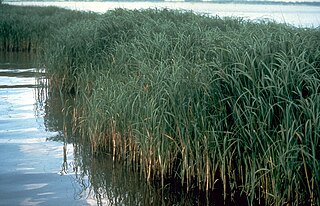
A halophyte is a salt-tolerant plant that grows in soil or waters of high salinity, coming into contact with saline water through its roots or by salt spray, such as in saline semi-deserts, mangrove swamps, marshes and sloughs and seashores. The word derives from Ancient Greek ἅλας (halas) 'salt' and φυτόν (phyton) 'plant'. An example of a halophyte is the salt marsh grass Spartina alterniflora. Relatively few plant species are halophytes—perhaps only 2% of all plant species.

Salicornia is a genus of succulent, halophyte flowering plants in the family Amaranthaceae that grow in salt marshes, on beaches, and among mangroves. Salicornia species are native to North America, Europe, South Africa, and South Asia. Common names for the genus include glasswort, pickleweed, picklegrass, and marsh samphire; these common names are also used for some species not in Salicornia. To French speakers in Atlantic Canada, they are known, colloquially, as "titines de souris". The main European species is often eaten, called marsh samphire in Britain, and the main North American species is occasionally sold in grocery stores or appears on restaurant menus, usually as 'sea beans' or samphire greens or sea asparagus.

Shirvan National Park — is a national park of Azerbaijan. It was established on July 5, 2003 within the territory of Salyan Rayon administrative districts. Its surface area is 54,373.5 hectares (543.735 km2).

The glassworts are various succulent, annual halophytic plants, that is, plants that thrive in saline environments, such as seacoasts and salt marshes. The original English glasswort plants belong to the genus Salicornia, but today the glassworts include halophyte plants from several genera, some of which are native to continents unknown to the medieval English, and growing in ecosystems, such as mangrove swamps, never envisioned when the term glasswort was coined.
Sea pickle is a common name for several plants and animals and may refer to:
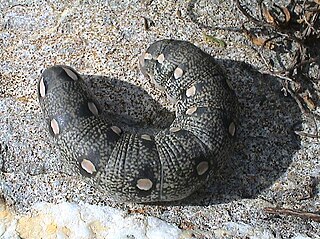
Hyles vespertilio is a moth of the family Sphingidae.

Gamla Varberg is a nature reserve in Varberg Municipality, Sweden. It was established in 1966.
Caloptilia flava is a moth of the family Gracillariidae. It is known from southern Russia and Rhodes.

Coleophora atriplicis is a moth of the family Coleophoridae found in Europe and North America.
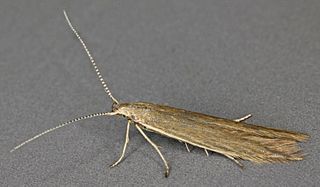
Coleophora alticolella is a moth of the family Coleophoridae, found in Europe and North America.

Orthotylus rubidus is a species of bug from the Miridae family that can be found in European countries such as Austria, Bulgaria, France, Germany, Great Britain, Greece, Moldova, Romania, Slovenia, the Netherlands, Ukraine, and northwest Russia. It is small, red and feeds on Salicornia in saline environments.

Salicornia europaea, known as common glasswort or just glasswort, is a halophytic annual dicot flowering plant in the family Amaranthaceae. Glasswort is a succulent herb also known as ‘Pickle weed’ or ‘Marsh samphire’.As a succulent, it has high water content, which accounts for its slightly translucent look and gives it the descriptive name “glasswort.” To some people, it is known as “chicken toe” because of its shape. To others, it is called “saltwort.” It grows in various zones of intertidal salt marshes, on beaches, and among mangroves.
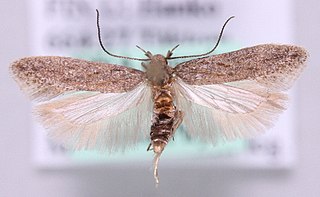
Scrobipalpa nitentella, the common sea groundling, is a moth of the family Gelechiidae. It is found in most of Europe, North Africa (Tunisia), Turkey, Afghanistan, Kazakhstan, China, Mongolia and Siberia (Transbaikalia).
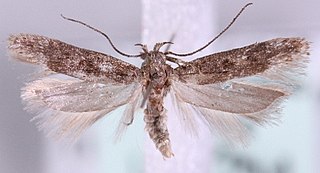
Scrobipalpa salinella, the sea-aster groundling, is a moth of the family Gelechiidae. It is found Europe, along the coast and in inland halophytic habitats. In the east, the range extends through Siberia and Central Asia to Mongolia. It is also found in North Africa.

Gynnidomorpha vectisana, the small saltern conch, is a moth of the family Tortricidae. It was described by Henry Noel Humphreys and John O. Westwood in 1845. It is found in China, Japan, Korea, Ireland, Great Britain, Scandinavia, the Benelux, Germany, the Czech Republic, Slovakia, Hungary, Romania, Switzerland, Austria, Italy, Spain, the Baltic region and Russia. The habitat consists of saltmarshes, fens, wet heathland and freshwater marshes.
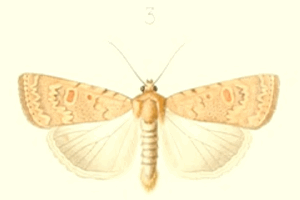
Caradrina flava is a moth of the family Noctuidae. It was described by Charles Oberthür in 1876. It is found in Spain and Greece and on Malta and the Canary Islands, as well as from the Sahara to the Arabian Peninsula, Israel, Jordan, the Levant, Iran and Iraq.
Peter William Ball is an English-born botanist, plant collector, and plant taxonomist, specializing in caricology.
Zunongwangia atlantica is a Gram-negative and rod-shaped bacterium from the genus of Zunongwangia which has been isolated from the deep-sea wate from the Atlantic Ocean.
Zunongwangia endophytica is a Gram-negative and rod-shaped bacterium from the genus of Zunongwangia which has been isolated from the plant Halimione portulacoides from Ria de Aveiro in Portugal.
Zunongwangia mangrovi is a Gram-negative, rod-shaped, strictly aerobic, slightly halophilic and non-motile bacterium from the genus of Zunongwangia which has been isolated from the mangrove Avicennia marina from Tamil Nadu.
References
- 1 2 "Species: Zunongwangia flava". LPSN.DSMZ.de.
- 1 2 Cho, Eui-Sang; Cha, In-Tae; Choi, Hak-Jong; Roh, Seong Woon; Nam, Young-Do; Seo, Sung Man; Seo, Myung-Ji (December 2018). "Zunongwangia flava sp. nov., belonging to the family Flavobacteriaceae, isolated from Salicornia europaea". Journal of Microbiology. 56 (12): 868–873. doi:10.1007/s12275-018-8231-z. PMID 30361977. S2CID 53028031.
- ↑ "Zunongwangia flava". www.uniprot.org.